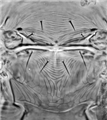Scirtothrips dorsalis
Recognition data
Distinguishing features
Both sexes fully winged. Body mainly yellow, with dark brown antecostal ridge on tergites and sternites and small brown area medially; antennal segment I white, II � III shaded, V � VIII brown; major setae not dark; forewings often shaded. Head wider than long; ocellar triangle and postocular region with closely spaced sculpture lines; three pairs of ocellar setae present, pair III close together between median points of hind ocelli; two pairs of major postocular setae present. Antennae 8-segmented; III � IV with forked sensorium. Pronotum with closely spaced sculpture lines; posterior margin with four pairs of setae, S2 prominent and about 30 microns long. Metanotal posterior half with parallel longitudinal sculpture lines; median setae arise behind anterior margin; no campaniform sensilla. Forewing first vein with three setae on distal half, second vein with two widely spaced setae; posteromarginal cilia straight. Abdominal tergites III � VI median setae small, close together; II � VIII with lateral thirds covered in closely spaced rows of fine microtrichia, these microtrichial fields with three discal setae, posterior margin with fine comb; tergite VIII with comb complete, lateral discal microtrichia extending medially; tergite IX with several rows of discal microtrichia. Sternites without discal setae, covered with rows of microtrichia except anteromedially; posterior margins without comb of microtrichia. Male smaller; tergite IX posterior angles without pair of stout drepanae; hind femora without a comb-like row of stout setae; sternites without glandular areas.
Related and similar species
The two species S. aurantii and S. dorsalis are unusual within the genus in having the abdominal sternites covered with microtrichia. S. dorsalis has the wing cilia straight not wavy, but although the species is now established in Florida and the Caribbean, it has not yet been found in California. The genus Scirtothrips currently includes 100 listed species from various parts of the world. Bailey (1964) provided keys to 13 from North America, but that work was based on specimens that were not fully cleared, and thus few structural details were available concerning differences between species. Similarly, Johansen & Mojica-Guzman (1998) provided keys to 33 species from Mexico, but doubts have been expressed concerning the biological reality of many of these (Mound & zur Strassen, 2001). Hoddle & Mound (2003) provided information on 21 Scirtothrips species from Australia, and Rugman-Jones et al. (2006) produced a molecular key to several pest species in this genus. Relationships of various Scirtothrips species based on molecular data are further considered by Hoddle et al. (2008).
Taxonomic data
Current valid name
Scirtothrips dorsalis Hood
Original name and synonyms
Scirtothrips dorsalis Hood, 1919: 90
Anaphothrips andreae Karny, 1925: 24
Neophysopus fragariae Girault, 1927:1
Heliothrips minutissimus Bagnall, 1919: 260
Scirtothrips padmae Ramakrishna, 1942: 169
Family placement
Thripidae, Thripinae
Common names
Strawberry thrips; Chilli thrips
Biological data
Life history
Breeding on young leaves, but sometimes collected from flowers.
Host plants
Highly polyphagous, although local populations may show some specificity.
Tospoviruses vectored
None
Crop damage
Feeding damage to various crops, including Lotus in Taiwan, tea in Japan, and Capsicums in Israel.
Distribution data
Area of origin
Southeast Asia
Distribution
Not yet recorded from California. Widespread across Asia, between Pakistan, Japan and Australia; introduced to Israel and the Caribbean area, and probably spreading in the world horticultural trade.








